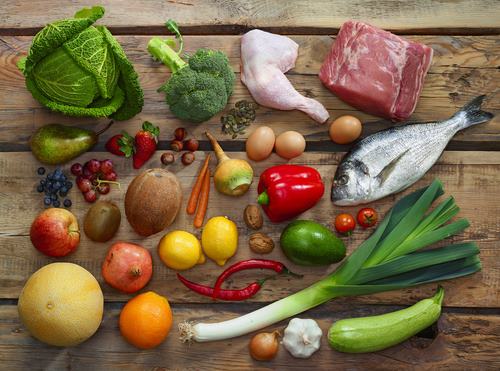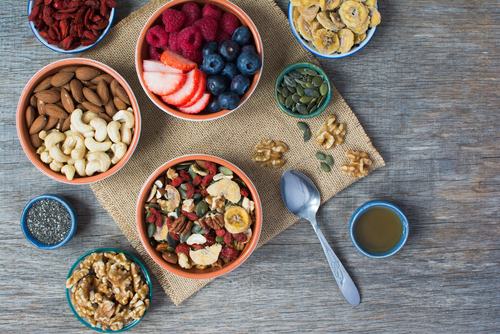Keto Diet Food List- The Complete Guide
THIS POST MAY CONTAIN AFFILIATE LINKS. PLEASE SEE OUR FULL DISCLOSURE POLICY FOR DETAILS.
Eat fat to burn fat? That’s just one premise behind the Keto diet, which is very low in carbohydrates and very high in fat, with a low to moderate amount of protein.
Similar to other low-carb diets, the Keto diet designed to bring on a physical state called ketosis, which is a metabolic survival process. It works like this: When the body runs out of carbohydrates to burn it starts to burn fat, releasing ketones as it does so.
Ketosis usually begins three to four days into a diet that reduces carbs to less than 50 grams per day, and as long as protein intake is kept between .06 and 1 gram per pound of your body weight. Keeping protein levels low to moderate eliminates the potential for gluconeogenesis, a process by which the body transforms protein to glucose in the absence of carbohydrates. It takes some planning and tracking to keep ketosis going, plus adjustments as you lose weight, but your efforts will pay off since ketosis enhances fat burning, helps you maintain your lean muscle mass, and even helps reduce hunger pangs.
As you might imagine, the Keto diet food list 2017 is fairly restricted – but not all carbs are forbidden. It is entirely possible to enjoy quite a bit of variety while following this plan and still get your body into ketosis and keep it there.
What are the benefits of the Keto Diet?

Before looking into the benefits of the Keto diet, it’s important to note that there are some individuals who should not participate in this plan. If you are someone who:
- Takes medication for high blood pressure
- Relies on insulin or other medications for diabetes management
- Is pregnant
- Is currently breastfeeding
Then the keto diet is probably not safe or ideal for you to follow. Keep in mind that there are exceptions, and talk to your doctor about whether this plan might work for you.
If you don’t fall into any of the categories above and you decide to give this plan a try, then you can expect to enjoy a variety of benefits by adhering to the keto diet, weight loss chief among them. Other benefits include:
- Reducing your risk of type 2 diabetes; in fact, some participants have been able to reverse their type 2 diabetes. The keto diet prevents blood sugar spikes and all the negatives that come with them.
- Improved endurance is another keto diet benefit; once you’ve tapped into your body’s fat reserves and are no longer dependent on available glycogen from carbs, you’ll find that your ability to get through even intense gym sessions increases drastically.
- Where some diets leave you feeling groggy, the keto diet may enhance your ability to focus. This benefit is also linked to the lack of sugar spikes – there are no crashes, so your brain enjoys a steady flow of focus-enhancing energy. Note that this benefit usually arrives between 3 to 7 days into the keto diet; the transition period may bring on headaches and you might have trouble focusing as your body switches its fuel source from carbs to ketones.
- No more sugar cravings! Like other low-carb diets, stops you from craving sugar. This is another benefit that takes at least a few days to kick in. Before the cravings go away, you might notice that they’re far more intense than usual. Ride them out to enjoy complete control.
Improved digestion, less risk of heartburn, and better blood pressure are some other common keto diet benefits.
Sample Shopping List

The basic Keto diet grocery list is ultra-simple, and shopping is easy. One word of advice: Don’t shop for the keto diet when you’re hungry, since you’re more likely to slip up and purchase undesirable items. Fuel up on fat and a bit of protein first, and you’ll find it far easier to stick to these basics:
- All unprocessed meats, preferably wild, organic, grass-fed or pasture raised; fatty cuts are best
- All unprocessed fish and seafood, preferably wild-caught; look for fatty fish like salmon
- Eggs, preferably pasture-raised and/or organic
- Processed meat without sugar or other carbohydrate sources added, i.e. bacon, sausage, ham, and other deli meats (Read labels carefully and look for those that mention 0 carbohydrates)
- Fats and oils – Look for natural fats and avoid hydrogenated, partially-hydrogenated, and trans-fats. Some good ones include avocado oil, olive oil, coconut oil, and butter. Saturated and monounsaturated fats are fine.
- Fruits in moderation – raspberries and blackberries are two good choices since they’re low in sugar. Check sugar levels to see how much a serving contains, and make decisions based on your desired carbohydrate intake.
- Full-fat dairy – When it comes to dairy, be sure to read labels since some items can be high in carbohydrates. Watch out for items with additives, i.e. flavored yogurt.
- Nuts and seeds – Look for plain or salted nuts and seeds with no sugary flavorings. You can eat these in moderation; they do contain carbohydrates so measure carefully to keep ketosis going strong.
- Nut butters – Choose unsweetened varities high in fat, i.e. almond, macadamia, and cashew butter
- Pickles and condiments – Look for items with no sugar and little to no carbohydrate content. Olives, dill pickles, mayonnaise, fermented foods like sauerkraut and kimchi, pesto, and mustard are some top choices.
- Vegetables – Look for vegetables that grow above ground, with the exception of corn and peas (both are high in sugar). Leafy greens are best – in fact, you should try to include some in each meal you eat.
Overview

Many people who are new to the Keto diet are surprised to learn that this way of eating was developed as a method to help reduce or even eliminate seizures in people suffering from epilepsy. This, of course, is done with the help of medical professionals who provide careful monitoring along the way.
If your aim is to lose weight by following the keto diet, then you’re in good company. One of the reasons this plan is so popular is that it really does work – and unlike crash diets that simply reduce the amount of calories coming in while perhaps increasing the amount of calories being expended through exercise, it reduces the body’s fat content while keeping muscle mass intact. The fat you’re eating keeps you feeling full, and ketosis itself has a dampening effect on hunger, so you naturally eat less. You’ll want to ensure that you don’t overeat though, so choose a calorie target based on 10 calories per pound of your desired body weight and stick to it. If, for example, you’d like to weigh 150 pounds, then set your daily intake to 1,500 calories. Besides watching your intake, you can use strips to ensure that you’re staying on track with ketosis. If you need help with recipes, check our steak recipes.
As you might have guessed, exercise will accelerate your fat loss while you’re on the keto diet. Be sure to choose an exercise plan that’s fun for you so that you’ll stick to it. And, if it has been a while since you enjoyed regular physical activity, start slowly and work your way up to a higher activity level so that you don’t overdo it and injure yourself. Remembering that it took time to gain weight and it also takes time to lose weight can help keep you from feeling discouraged, whether you decide to follow the Keto diet or another plan like Whole30, Paleo, or Dr. Sebi.
Besides choosing a wide variety of nutritious items for your Keto beginner grocery list, there are a few foods to eat only occasionally, and some foods to avoid on the Keto diet. Check also our Ketogenic food list
Ketogenic Diet: Foods to Eat Occasionally
- Cocoa powder or carob powder
- Coconut
- Dry red wine, dry white wine, unsweetened spirits (measure carefully to stay in ketosis)
- Fermented soy products like tempeh (measure carefully to stay in ketosis)
- Mushrooms
- Nightshade vegetables, i.e. eggplant, tomatoes, and peppers
- Lower-calorie root vegetables, i.e. onions, shallots, and garlic
- Very low sugar fruits such as berries and rhubarb (measure carefully to stay in ketosis)
Ketogenic Diet: Foods to Avoid
- All artificial sweeteners, which can increase sugar cravings and make life harder for you
- All concentrated sugars, i.e. agave nectar, table sugar, honey, high-fructose corn syrup, etc.
- All grains, i.e. wheat, quinoa, spelt, rye, barley, etc.
- All products made with grain or sugar, i.e. baked goods, ice cream, soft drinks, sports drinks, etc.
- Candies and gum containing sugar
- Dried fruit
- Legumes
- Potatoes
- Most processed foods with the exception of items like pickles, sugar-free condiments, canned vegetables, etc. (Let carbohydrate content be your guide, and avoid additives for added health benefits)
Ketogenic Diet: Food List for Weight Loss – Avoid these items
If your goal is to lose weight, you can enjoy a wide variety of Keto diet foods. Weight loss will occur as long as you watch your calorie intake, and as long as you keep your carb and protein intake at proper levels for maintaining ketosis. While losing weight, avoid the following:
- Alcohol in any form
- Beverages other than water, tea, and coffee (be sure that your tea and coffee drinks don’t contain added sugar or other sources of carbohydrates)
- Very sweet, high-sugar fruits like apples, oranges, cherries, etc.
- All items from the keto diet “foods to avoid” list above
Keto Diet Snacks
Keep keto diet snacks available so you’re never tempted to eat something you might regret later. Some ideas:
- Celery sticks, cucumbers, pickles, and cherry tomatoes
- Celery sticks with nut butter
- Celery sticks or cucumber rounds dipped in guacamole
- Hard-boiled eggs
- Jerky (Choose carefully since some flavors contain sugar)
- Kale or seaweed chips
- Nuts
- Pork rinds
- Pre-packaged full-fat cheese sticks or rounds like Laughing Cow
- Quest bars
Tip:
Take a list with you when shopping and plan to take some time to read labels. especially as you’re learning which foods are lowest in carbohydrates.

